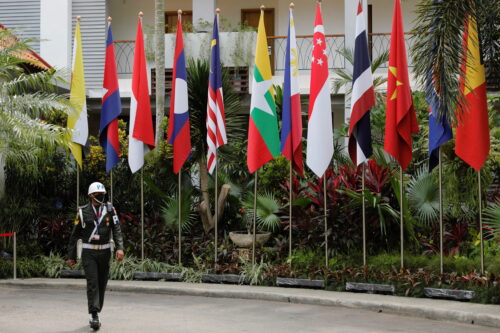This article is brought to you by Xi’an Jiaotong-Liverpool University, a leading international joint venture university based in Suzhou, Jiangsu, China.
There’s a popular perception that the modern history of innovation is defined by tech geniuses and charismatic entrepreneurs who built fortunes on mastery of problem-solving skills and unfettered imagination. This idea is not entirely without merit: In the U.S., creative thinkers like Mark Zuckerberg and Elon Musk have brought to life their visions of the technological future through respective companies, inventing a variety of life-altering services and products hailed around the world.
But the rule is not applicable in China, where idolization of individual inventors is rare and the government’s influence is pervasive. While some people might think of central planning and state intervention as inherently inimical to fresh ideas, China’s unique approach to innovation — which sees state-owned enterprises (SOEs) playing a crucial role — has proven to be fruitful.
Locally motivated, globally minded
A rarity in the West, state-owned entities have long been the backbone of China’s economy. Before former leader Dèng Xiǎopíng 邓小平 unleashed China’s pent-up capitalist energy in 1978, the government — under a decades-long policy of central planning — directed and controlled a large share of the country’s economic resources, with SOEs accounting for the majority of the gross industrial production and output.
As a result of a flurry of progressive reforms, China’s SOEs also underwent significant changes in the past few decades. By the 1990s, many firms in the state sector had converted to the model of modern corporations, with the central government consolidating its control over large SOEs while withdrawing from small ones.
Although private businesses have emerged and flourished, SOEs still enjoy dominance in certain areas such as public infrastructure, as they bear the capacity and official backing to big projects that are aligned with the government and the people’s needs.
“Essentially, large infrastructure requires considerable investment and implies a rather long payback period. SEOs are uniquely positioned to take on these projects, as they are under less pressure to generate immediate profits compared with private, small firms. Therefore, they can focus more on forward-looking projects and long-term gains,” says Dr. Xiao Wang, Associate Professor in Innovation and Entrepreneurship at Xi’an Jiaotong-Liverpool University. Wang is the co-author of Catch-up and Radical Innovation in Chinese State-Owned Enterprises, a 2021 book exploring how, in the past decade, Chinese SOEs have achieved technological innovation in the large infrastructure sector.
Beyond acknowledging the built-in advantages of SOEs, putting them to the task of infrastructural innovation is also a strategic decision made by the government, Wang says. “If we take the Chinese government as an entrepreneur, the very critical task for it is to identify a ‘huge’ window of opportunity that could not only benefit one or a few companies, but also accelerate the growth of multiple strategic industries and the economy as a whole,” Wang adds.
Because well-developed infrastructure is pivotal to the general economic development in China, the government has prioritized large infrastructure’s advancement in its innovation efforts, Wang notes, adding that “large infrastructure projects can benefit other countries, too.”
Top-down success
As of 2021, China, the world’s second-largest economy, had more than 150,000 SOEs, the largest number of government-owned entities in the world. With many of them heavily invested in infrastructure research and development (R&D), a host of breakthrough innovations have come to fruition, including high-speed trains, ultra-high-voltage power transmission, and fourth-generation (4G) mobile telecommunications, Wang notes.
For Chinese SOEs, encouraging policies and practices introduced by the government have created a friendly environment for innovation. Since the early 2010s, there have been “a range of policies issued by several ministries and departments pushing SOEs forward in technological innovation,” says Wang.
For example, in the 12th edition of China’s Five-Year Plan (2010–2015), a comprehensive policy blueprint released by the central government every five years to guide China’s economic and social development, an array of SOEs were selected to lead 16 mega projects, such as general-purpose central processing units (CPUs), large commercial aircraft, next-generation telecommunications technology, nuclear power plants, new drugs, and lunar exploration. “Of course, the subsequent support was provided as well, including tax relief and subsidies,” Wang adds.
More recently, in a policy document issued last year, the State-owned Assets Supervision and Administration Commission of the State Council (SASAC), a special commission of the central government that oversees and supports innovative efforts at SOEs, vowed to “guide central SOEs to take further advantage of opportunities generated by the new technological revolution and industrial transformation during China’s 14th Five-Year Plan period (2021–2025), while keeping liabilities under control.” In November 2022, China’s securities regulator announced that it would support bond issuance by central SOEs to fund tech innovation.
According to China Daily, central SOEs’ total expenditures on R&D amounted to 378.62 billion yuan ($55.9 billion) in the first half of 2022, an increase of 19.7% compared with the previous year. Meanwhile, Wang stresses that a number of private enterprises and foreign companies also participated in China’s innovation ecosystem with substantial contributions, such as the development of LTE-TDD (4G).
“Essentially, if the radical innovation relates to a great scale of market demand across countries and there are a range of private or foreign companies that have relevant know-how, it’s quite reasonable to involve different types of companies in the ecosystem for better viability, efficiency, and sustainability of the innovation,” he says.
What the future holds
As listed in SASAC’s 2022 policy document, cutting-edge technologies like computer chips, advanced trains and vessels, narrow-body airliners, and 5G telecommunications equipment are some of the key areas that it expects SOEs to focus on in the next few years. As China seeks to seize the fourth Industrial Revolution — a 21st-century movement that’s characterized by the marriage of physical assets and advanced digital technologies — the development of “broad-sense new infrastructure around big data and artificial intelligence requires SOEs’ participation as well,” Wang adds, especially in advanced technologies that can be used for the greater good of society, such as power storage, blockchain, and driverless transportation.
Many of these strategic technologies rely on chip manufacturing, an increasingly major focal point in the battle for technological superiority between the U.S. and China. To hobble China’s progress in the semiconductor industry, the U.S. government introduced sweeping export controls that banned Chinese companies from buying advanced chips and chip-making equipment without a license. Meanwhile, U.S. companies have pledged nearly $200 billion for chip manufacturing projects since early 2020.
Although the restrictions on chipmaking will affect Chinese SOEs’ innovation, the extent of the impact “depends on the SOEs’ technological trajectories,” says Wang. “Thanks to the entrepreneurship of the Chinese government and its ability to mobilize and integrate divergent resources across the board, the collaborative innovation and forward engineering may drive autonomous innovation in chip technologies, fostering new technological trajectories.”
But outside key pillar industries, it’s an uphill task for Chinese SOEs to develop impactful innovations. Empirical evidence in academic papers and studies suggests that in general, private firms are more innovative than SOEs in China. Critics argue that when government officials take on the role of representatives of ownership in state-owned companies, those who run the enterprises are less driven to innovate in order to earn a competitive edge in the market. In contrast, in a market economy, employees are more inclined to innovate, as they feel personally invested in a collective success and are held accountable by the business owner.
As countries around the world race to foster innovation in emerging fields, Wang says that China needs to make notable strides in a few areas to become a global innovation leader, including talent recruitment and cultivation, management of organizations, inter-organizational collaboration, and striking a dynamic balance between state and market logic.








